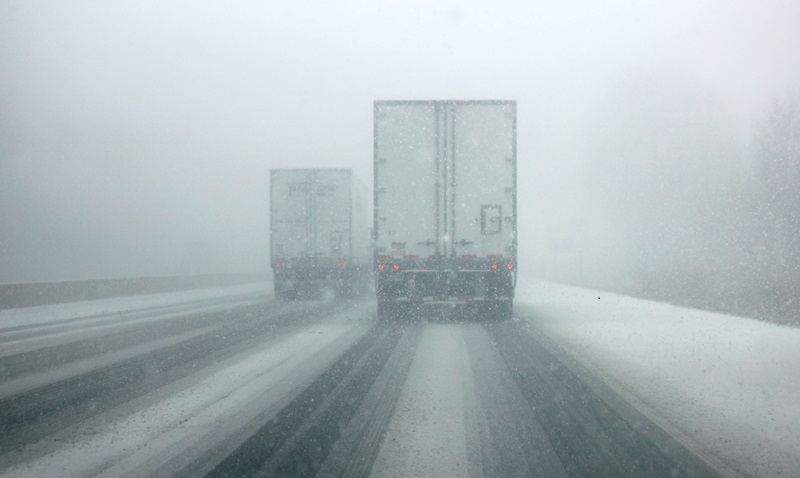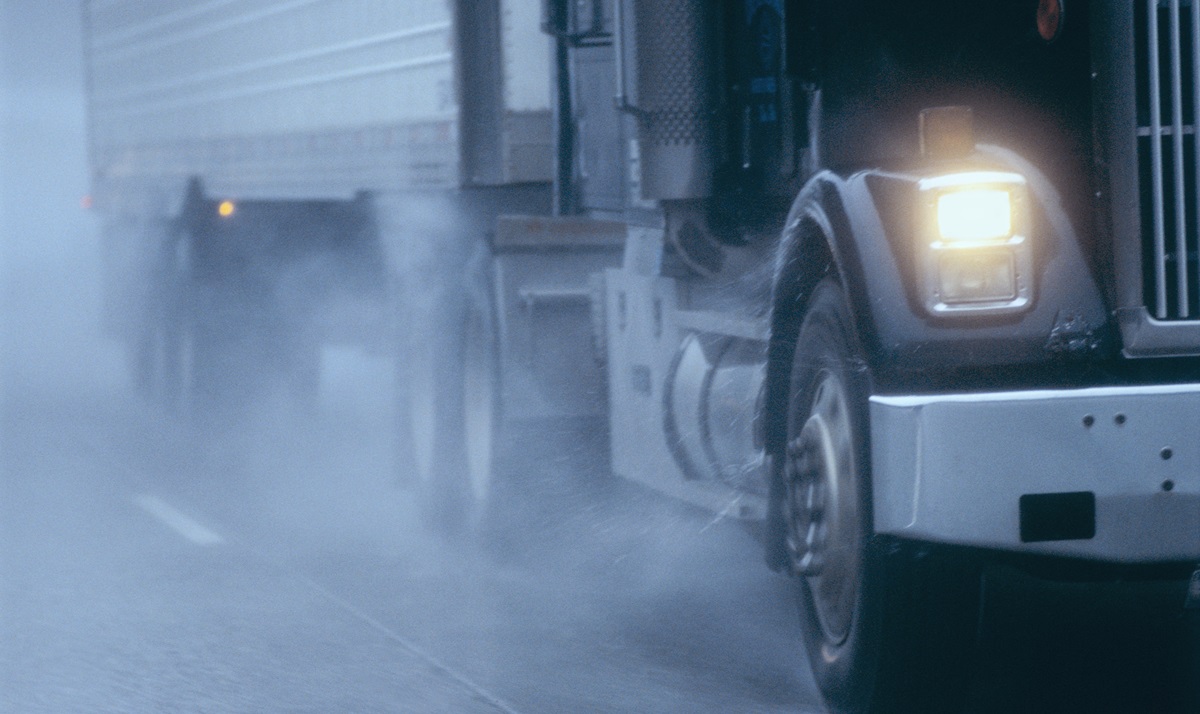How Weather Conditions Affect Truck Insurance: Navigating Rain, Snow, and More
Weather conditions affect your truck insurance premiums.
How?
Learn how risky weather conditions impact your commercial truck insurance and what you can do about it!
Different weather conditions are responsible for 25% of truck delays. Out of 5,891,000 vehicle crashes, nearly 1,235,000 are weather-related.
While some weather gives plentiful warnings and allows truckers to take required precautions, other extreme conditions can quickly turn serious and impact the entire operation.
FHWA (Federal Highway Management Program) RWMP (Road Weather Management Program) suggests that annually 1.3 million traffic accidents are caused by different weather conditions.
Not only weather conditions are capable of deranging your trucking operations, but also impact your vehicle coverage rate. Yes, you read that right!
Weather conditions you frequently encounter in your journey are factored in while calculating your trucking insurance. How?
In this post, we will help you understand how weather conditions affect truck insurance, the driver, and the entire transportation. Plus, some safety tips to apply while driving in different weather conditions on the road.
But!
First, let’s start with how weather conditions impact transportation and the trucking industry.
How Mild to Extreme Weather Conditions Impact Trucking and Logistics?
Events of weather have a massive impact on the trucking and logistics industry. Weather impacts a trucking company’s entire delivery process, increases idle time and expenses, and much more.
Plus, weather carries hazards to the safety of the driver, other vehicles, and people on the road.
The United States Department of Transportation reports that up to 21% of crashes on the road are weather-related. 46% of crashes happened during rainfall and 70% occurred on wet pavement.
According to the Federal Highway Administration, 25% of truck delays are caused by weather conditions. Plus:
- Extreme weather conditions alone cost up to $3.5 million to the trucking industry annually.
- Snowy and Icy weather caused more than 50% of delays in the logistics.
- Lost capacity due to hurricanes and blizzard conditions costs over $100 million per day.
Now, you have understood how different weather conditions impact the trucking and logistics industry. Let’s take a look at some weather-related factors that precisely affect your truck coverage cost.
Want to insure your fleets? Get free truck insurance quote now.


How Weather Conditions Affect Truck Insurance?
Now, you must be thinking about how different weather conditions affect truck insurance. Let’s understand this with some key pointers.
Risky Operation
Heading on a journey that has snow, frozen ice, flooded roadways, or high winds makes the entire trucking operation highly risky. When your truck insurance premiums are calculated, the policy provider analyzes all the risks in your operation before offering a final price.
If you seem a risky buyer, your rate of premium tends to go up as there is a high chance of frequent claims.
Truck Delays
As already discussed, 25% of truck delays are weather-related, this obstruction can make your truck insurance cost go higher. How? Weather conditions cause delays in deliveries. If this happens recurrently, your trucking company’s reputation gets negatively affected. Even a small spot in your trucking business can set out a message that your brand is not trustworthy. As a result, you start losing your customers which impacts your overall revenue.
Not being able to earn the anticipated revenue can lead you to a situation where you face difficulty in keeping up with the unavoidable trucking expenses including fuel. You might start using credit cards and if you fail to keep up with its repayments, your credit score goes down.
The way you handle your credit scores greatly impacts your insurance rates. A high credit score means low-cost insurance, whereas low credit scores lead to expensive trucking policies.
More Halts
You might handle the additional cost of fuel, likely fines, frequent stop-offs, and pickups for a while. However, regular weather events can take a toll on your budget. More halts lead to higher idle time and can impact the supply chain.
When your truck takes frequent halts in the journey, it gets vulnerable to potential risks like theft, vandalism, etc. This makes your trucking prone to likely and unlikely dangers which is factored in while calculating your truck insurance premiums.
Diversion Routes
When weather conditions are bad, truckers either wait to get the situation back to normal or take alternate routes. Again, in the case of diverting routes, additional fuel consumption and delays in deliveries come into the picture.
Such frequent diversions quickly add up and increase your expenditures. This doesn’t go well with your reputation which precisely impacts your truck insurance rates.
Shipment Delays
Cargo that you haul from one point to another is an essential part of your business. You can say that it is the sole factor that acts as the lifeblood of your trucking business. Weather-related problems can impact your delivery timelines which can upset your customers.
Although your cargo insurance takes care of the potential risks to the shipment, the delay is one thing that completely works against your trucking business. As already discussed, delays in shipment deliveries can lead to loss of customers which directly impacts your truck insurance rates.
If it seems that your cargo insurance premiums are going higher, check out this blog on top methods to lower cargo insurance rates.
Essential Tips To Drive Safely in Different Weather Conditions on the Road
Now you have thoroughly understood how weather conditions can affect truck insurance premiums and the overall supply chain. Let us introduce you to some safety trucking tips while driving in different weather conditions, so you can protect yourself, your operations, and your commercial trucks.
Snow/Ice
Snowy weather not only limits visibility but also makes the road slippery as ice gets frozen on the pavement. It is better to follow the below-mentioned tips to increase your safety in snowy/icy weather conditions.


- Slow down: When there is a snowfall, overpasses and bridges are the first ones to freeze. Therefore, slow down wherever you need to change direction. Avoid sudden speed changes.
- Clear window: Snowfall leads to limited visibility. If you want to drive safely, you cannot compromise with visibility in bad weather conditions. Keep the lights and wipers ‘ON’ if necessary. Keep scraping the ice from your windows before starting your truck. Also, keep your back window area clean. If you still find it difficult to get clear visibility, pull over in a safe location carefully for some time.
- Careful braking: Driving on an icy road is very challenging. A sudden brake can lead to loss of steering control and cause lock-up. If your trucks have anti-lock brakes, apply firm and constant pressure to the pedal and be very careful.
- Slow acceleration: If you experience a heavy snowfall in the journey and get stuck in between, you need to straighten all the wheels and apply slow acceleration. Avoid twisting the wheels and use blocks under them.
High/Strong Winds
High winds can lead to truck accidents. This type of weather condition can make it tough to look at flying debris, pile of dust, or other objects charging towards your vehicle. Wind-driven snow, debris, and piles of rocks can obstruct the entire lane and trucking operations. It is recommended to follow these tips to maintain your and your vehicle’s safety during high winds.
- Cautious lookout: You need to be alert and always watch out for flying debris and objects while driving in high winds. Try being extra cautious when driving near vans, cars, light cargo-carrying vehicles, and other truck trailers. Take extra precautions near overpasses and bridges as these places become extremely dangerous during such weather conditions.
- Consider Waiting: Sometimes maintaining control of your trucks in high winds with more than 50 mph is almost impossible. You can check predicted wind speeds, if there is no sign of improvement, consider waiting to get the weather normal because it is highly dangerous to drive a truck during high winds.
Rain
Slight rain causes friction in pavement and heavy one impacts the visibility while driving the truck. We recommend you follow the below-mentioned tips while operating in rainy weather conditions.
- Turn ‘ON’ wipers: Obvious tip but has to be in the safety checklist. Consider keeping all wipers maintained and replacing them between 6 to 12 months. You can use beam wiper blades to get optimal performance while driving in rainy conditions. You can also check out our blog on the commercial truck maintenance checklist to uplift the overall health of your vehicle.
- Keep windows clean: Wipers keep your truck’s windshield clean from the outside but the glass should be clear from inside as well to get better visibility. You can use an air conditioner or defroster to keep windows clean from inside.
- Use headlights: Visibility gets compromised during heavy rains. You can use truck headlights as they can greatly help in such conditions. Please note that using headlights in low visibility is one of the mandatory requisites in all states.
- Avoid crossing flooded roadways: Flooded roadways are not only capable of causing damage to the internal equipment but also pose a danger to the entire vehicle. This is because it is difficult to analyze the deepness of water in flooded roadways. So, it is recommended to find an alternate route when you encounter such a situation.
- Be patient: You need to be very patient while driving in rainy conditions. Consider keeping more than usual distance from other vehicles on the road. This is because wet roads cause loss of traction and might lead to sliding or skids.
Fog
Fog is another type of weather condition that impacts the visibility of a trucker while driving the vehicle. If you can’t stop and need to reach your destination during a dense fog situation, follow these tips to increase your safety.
- Turn ‘ON’ fog lights: Obvious but has to be in our safety tip. Turn ‘ON’ the fog lights. Plus, keep the truck headlights ‘ON’ and set it to a low beam.
- Lane markers: If the fog is too dense and the visibility is poor, you can keep your eyes on the lane markers and drive slowly to keep moving ahead.
- Warm AC: You should keep your windshield clean from the mist that tends to form inside during foggy weather conditions. Select a warm windshield AC setting to clear off the internal mist to improve visibility.
- Avoid Parking: Avoid stopping during foggy conditions as it is hard for others to see that a truck is parked ahead of the road. This increases the chances of accidents and bad collisions.
Dust Storm
Dust storms or smoky weather conditions are another factor that impacts the visibility on the road. First, you should avoid driving in a dust storm but if it is necessary to move ahead, keep the following tips in check.
- Headlights: Keep your truck headlights ‘ON’ whenever you drive in smoky conditions or dust storms.
- Speed: Avoid driving at speed. Maintain control of your truck and drive at appropriate speed.
- Hazard lights: Turn ‘ON’ your truck’s hazard lights to increase your vehicle visibility to other autos moving on the road. This will help you avoid collisions.
- Honking: Keep blowing the horn occasionally to alert other drivers on the road. This will help you prevent likely accidents.
- Stop: If a storm is getting bad, don’t wait until it becomes worse. Try pulling off the road sooner, exit the roadway if you can, and stop in a safer place for a while.
Heat
Extreme heat is as dangerous as snow, dust storms, high winds, and any other weather conditions. Heat can affect several things on your vehicle including the wheels. You need to be prepared for extreme heat conditions with the following tips:
- Extra water: Make sure that you carry extra water whenever you take a halt. You need to stay hydrated all the time to avoid heat stroke and dehydration during your journey.
- Start early: If you are traveling in a location with high temperatures, you can start early in the morning or later in the evening as the air is comparatively cooler than it is in the afternoon. This will reduce the impact on tires and all other parts of your trucks that can be affected by extreme heat conditions.
The Bottomline: How Weather Conditions Affect Truck Insurance
The average monthly cost of commercial truck insurance is showing no sign of decrease. However, with the right driving safety tips, you can keep your trucking operations safe from bad weather conditions.
By now, you must have understood how weather conditions affect truck insurance and why it is very important to take care of your trucking operations with extra precautions.
While slowing down and staying vigilant on the road make a big difference in your driving, following the aforementioned driving safety tips in different weather conditions greatly increases the chances of reaching your destination safely with the cargo.
If you need more assistance with your truck insurance, you can contact us and get personalized coverage at your affordability.
Want to insure your fleets? Get free truck insurance quote now.


Frequently Asked Questions on How Weather Conditions Affect Truck Insurance
Snow, rain, heavy winds, and other weather conditions can affect transportation and cause delays in deliveries. For instance, strong winds and rains limit visibility while driving which increases the odds of causes collisions and accidents.
Weather conditions affect truck insurance in many precise manners. We have discussed all the points on how weather conditions affect truck insurance rates in our blog.
Although heavy snow, wind, and rain are considered bad for trucking, dense fog is probably the most dangerous weather that causes accidents and collisions on the road.
Whenever you drive in snow or frozen ice, you should slow down and avoid exceeding 45 mph speed because you can lose control of your vehicle if you drive at high speed.






